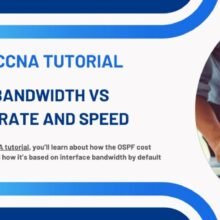Cisco OSPF Basic Configuration In this Cisco CCNA tutorial, you’ll learn how to do a basic configuration of OSPF on our Cisco routers. Scroll down for the video and also text…
Algorithmic Trading & Quantitative Analysis Using Python

Build fully automated trading system and Implement quantitative trading strategies using Python
Master Algorithmic Trading & Quantitative Analysis Using Python: Your Path to a Successful IT Career
In the rapidly evolving world of finance and technology, mastering algorithmic trading and quantitative analysis is becoming increasingly vital for aspiring IT professionals. Whether you’re a budding programmer or a seasoned techie looking to diversify your skillset, the Algorithmic Trading & Quantitative Analysis Using Python course on Udemy offers a comprehensive and accessible way to gain the expertise you need. In this blog post, we’ll delve into the course’s key learning topics and highlight how each module contributes to your IT career success.

Look what you are going to learn
1. Algorithmic Trading and Quantitative Analysis Using Python
Are you intrigued by the concept of using data-driven strategies to make profitable trading decisions? The first module of this course introduces you to the exciting realm of algorithmic trading and quantitative analysis. You’ll uncover the principles of developing algorithmic trading strategies and implementing them using the powerful Python programming language. From understanding market behavior to predicting price trends, this module equips you with the foundational knowledge needed to excel in algorithmic trading.
Sample Code:
# Moving Average Crossover Strategy
def moving_average_crossover_strategy(data, short_window, long_window):
signals = pd.DataFrame(index=data.index)
signals['signal'] = 0.0
signals['short_mavg'] = data['Close'].rolling(window=short_window, min_periods=1, center=False).mean()
signals['long_mavg'] = data['Close'].rolling(window=long_window, min_periods=1, center=False).mean()
signals['signal'][short_window:] = np.where(signals['short_mavg'][short_window:] > signals['long_mavg'][short_window:], 1.0, 0.0)
signals['positions'] = signals['signal'].diff()
return signals
2. Carrying Out Both Technical and Fundamental Analysis Programmatically
Successful trading isn’t just about numbers; it involves a blend of technical and fundamental analysis. In this module, you’ll learn how to leverage Python to analyze price charts, identify patterns, and make data-driven trading decisions. You’ll also dive into fundamental analysis, where you’ll programmatically extract and analyze financial data to gauge the health and performance of companies. By merging these two approaches, you’ll have a comprehensive toolkit to navigate the complexities of modern financial markets.
Sample Code:
# Bollinger Bands Strategy
def bollinger_bands_strategy(data, window, num_std_dev):
signals = pd.DataFrame(index=data.index)
signals['signal'] = 0.0
rolling_mean = data['Close'].rolling(window=window, min_periods=1, center=False).mean()
rolling_std = data['Close'].rolling(window=window, min_periods=1, center=False).std()
signals['upper_band'] = rolling_mean + (rolling_std * num_std_dev)
signals['lower_band'] = rolling_mean - (rolling_std * num_std_dev)
signals['signal'][window:] = np.where(data['Close'][window:] > signals['upper_band'][window:], -1.0, 0.0)
signals['signal'][window:] = np.where(data['Close'][window:] < signals['lower_band'][window:], 1.0, signals['signal'][window:])
signals['positions'] = signals['signal'].diff()
return signals
3. API Trading
In the digital age, automation is the key to efficiency, and this module focuses on how to programmatically interact with financial markets through APIs (Application Programming Interfaces). You’ll learn how to access real-time market data, execute trades, and manage your portfolio—all using Python. By harnessing the power of APIs, you’ll be able to implement your trading strategies seamlessly and stay ahead of the curve in the fast-paced world of algorithmic trading.

Sample Code:
# Fetching Real-Time Price Data from API
import requests
def get_real_time_price(symbol):
url = f'https://api.example.com/market-data/{symbol}/price'
response = requests.get(url)
data = response.json()
return data['price']
Conclusion and Learning Recommendation
In a rapidly evolving IT landscape, adapting and upskilling are paramount for career success. The Algorithmic Trading & Quantitative Analysis Using Python course on Udemy offers a comprehensive and accessible journey into the world of algorithmic trading, quantitative analysis, and API-based automation. By mastering these skills, you’ll be equipped to harness the power of data-driven decision-making, stay ahead in the competitive job market, and contribute meaningfully to the fields of finance, technology, and beyond.
Invest in your future today by enrolling in this course and embarking on a transformative learning journey that will propel your IT career to new heights. Don’t miss out on the opportunity to gain a competitive edge and thrive in a world where data and technology intersect seamlessly. Your IT career’s success story begins here with the Algorithmic Trading & Quantitative Analysis Using Python course on Udemy.

Here are 20 multiple-choice questions along with their answers related to the topic of Algorithmic Trading & Quantitative Analysis Using Python:
Question 1: What is the primary focus of the “Algorithmic Trading & Quantitative Analysis Using Python” course? a) Blockchain technology b) Developing mobile apps c) Analyzing market trends and trading strategies d) Social media marketing
Answer: c) Analyzing market trends and trading strategies
Question 2: Which programming language is emphasized in the course for implementing algorithmic trading strategies? a) JavaScript b) Python c) Java d) C++
Answer: b) Python
Question 3: What is the purpose of technical analysis in algorithmic trading? a) Analyzing company financial reports b) Predicting market trends based on historical price data c) Creating marketing campaigns d) Designing user interfaces
Answer: b) Predicting market trends based on historical price data
Question 4: What is fundamental analysis in the context of trading? a) Analyzing technical indicators b) Analyzing market trends c) Analyzing financial data to evaluate company performance d) Analyzing social media sentiment
Answer: c) Analyzing financial data to evaluate company performance
Question 5: Which function can be used to calculate the moving average in Python for a given time window? a) mean() b) average() c) moving_average() d) rolling_mean()
Answer: d) rolling_mean()
Question 6: What is the significance of Bollinger Bands in technical analysis? a) They indicate overbought or oversold conditions in the market b) They identify potential trend reversals c) They display support and resistance levels d) They visualize the volatility of a security
Answer: d) They visualize the volatility of a security
Question 7: What is the role of APIs in algorithmic trading? a) They provide physical trading platforms b) They enable interaction with financial markets programmatically c) They analyze company financial statements d) They predict future price movements
Answer: b) They enable interaction with financial markets programmatically
Question 8: Which of the following functions fetches real-time price data from an API in Python? a) get_data() b) fetch_price() c) request_price() d) requests.get()
Answer: d) requests.get()
Question 9: What is the primary advantage of algorithmic trading? a) Higher risk exposure b) Emotional decision-making c) Faster execution of trades d) Lower transaction costs
Answer: c) Faster execution of trades
Question 10: Why is diversification important in a trading portfolio? a) It guarantees high returns b) It eliminates risk c) It reduces the need for analysis d) It spreads risk across different assets
Answer: d) It spreads risk across different assets
Question 11: Which type of analysis involves studying historical price charts and patterns? a) Fundamental analysis b) Quantitative analysis c) Technical analysis d) Predictive analysis
Answer: c) Technical analysis
Question 12: What is an ICO in the context of cryptocurrencies? a) Initial Coin Offering b) International Crypto Order c) Institutional Cryptocurrency Option d) Independent Currency Organization
Answer: a) Initial Coin Offering
Question 13: Which module in the course covers API trading? a) Module 1 b) Module 2 c) Module 3 d) Module 4
Answer: c) Module 3
Question 14: Which programming language is widely used for implementing algorithmic trading strategies? a) Ruby b) Python c) C# d) PHP
Answer: b) Python
Question 15: What is the primary focus of fundamental analysis? a) Predicting short-term price movements b) Analyzing historical price data c) Evaluating company financials and performance d) Developing technical indicators
Answer: c) Evaluating company financials and performance
Question 16: What is a moving average crossover strategy used for? a) Timing entry and exit points based on moving average intersections b) Predicting market crashes c) Analyzing trading volume d) Identifying potential IPOs
Answer: a) Timing entry and exit points based on moving average intersections
Question 17: What do Bollinger Bands consist of? a) A single line representing the average price b) Two lines representing the upper and lower price limits c) A scatter plot of price data d) A pie chart of trading volume
Answer: b) Two lines representing the upper and lower price limits
Question 18: Which analysis focuses on price and volume data to forecast future price movements? a) Quantitative analysis b) Sentiment analysis c) Technical analysis d) Fundamental analysis
Answer: c) Technical analysis
Question 19: What is the recommended programming language for API trading? a) Java b) Python c) C++ d) JavaScript
Answer: b) Python
Question 20: How does algorithmic trading contribute to minimizing emotional bias in trading decisions? a) It increases emotional attachment to trades b) It eliminates the need for technical analysis c) It relies solely on fundamental analysis d) It executes trades based on predefined rules and data
Answer: d) It executes trades based on predefined rules and data

In conclusion, the Algorithmic Trading & Quantitative Analysis Using Python course on Udemy is your gateway to unlocking a world of opportunities in the dynamic fields of finance and technology. By embarking on this educational journey, you’re not only acquiring practical skills but also gaining a competitive edge that will set you apart in the job market.
Imagine being able to confidently analyze market trends, create data-driven trading strategies, and execute trades programmatically using Python. This course empowers you with the knowledge and tools to navigate the complexities of algorithmic trading, enabling you to make informed decisions and optimize your portfolio.
Whether you’re a seasoned IT professional looking to diversify your skillset or a passionate beginner eager to delve into the world of finance, this course is designed to cater to all levels of expertise. With hands-on examples, real-world applications, and comprehensive modules, you’ll be well-equipped to thrive in the exciting realm of algorithmic trading.
Don’t miss out on this incredible opportunity to invest in your future. Enroll in the Algorithmic Trading & Quantitative Analysis Using Python course today and take a significant step toward realizing your career aspirations. Elevate your IT career with the power of data-driven decision-making and embark on a path that leads to innovation, growth, and success. Your journey starts now!









